A SHORT HISTORY OF THEATRE & CINEMA IN SALISBURY
By Frogg Moody
The early history of cinema and theatre in Salisbury both have links to Fisherton. Before we look at Cinema in Salisbury, we must look at theatre because the two are linked. I have been interested in theatre for a long time now, particularly the Palace Theatre that once stood on the corner of Endless Street and Chipper Lane. Theatre in Salisbury included a theatre in New Street which was established in 1777 and even earlier, the Vine that once stood in St. Thomas square which was closed in 1770. The Vine Theatre was massive in size and in 1752, Mr. Hallam’s London Company presented Romeo and Juliet by William Shakespeare, followed by a new dance and finally, a pantomime was performed – so you certainly got your monies worth in those days!
Another old theatre was the Sun on Fisherton Bridge. In 1823 Cooke and Bridges Circus was at the Sun when it became known the premises of Messrs. Wheeler, the hatters in the Market Place, were on fire. The crowds at the circus left so fast that the place was soon deserted. They preferred the exciting scene in the market square. Later the inn/theatre was converted into a Royal skating Rink under the patronage of Prince Leopold, and in 1880 it was converted into the Maundrel Hall. Today it is the Bridge Tap.

THE MAUNDREL HALL © Frogg Moody
The Victoria Hall’ was located in Rollestone Street and this particular hall has quite a history!
The hall began its life in January 1891 when the Salisbury Swimming Club and Steam Laundry Company Ltd. were formed. In 1892 a new pool was opened with a performance by the Beckwiths, a celebrated family of swimmers. It became a great attraction, for patrons appreciated the heated water, a luxury at the time.

THE BECKWITH FAMILY © Frogg Moody
Early in 1900 began the practice of covering the large swimming bath during the winter months: so it became a public hall, and from then it was called the ‘Victoria Hall’.
In the early 1920’s it was decided to completely renovate the Victoria Hall – it was to become a general place of assembly, to be let at a reasonable hiring fee. The scheme was carried out at considerable expense, and from the end of 1924 it was ready for booking. Salisbury citizens were able to enjoyed roller skating, dances, exhibitions, stage entertainments, boxing contests and all sorts of shows. It also proved useful for local societies including Salisbury Amateur Operatic Society. The hall was also part of the Salisbury Steam Laundry which was the scene of a terrible fire in 1922 – it was lucky that the Salisbury Fire Brigade was situated just down the road!

THE VICTORIA HALL HOSTED MANY EVENTS © Frogg Moody

THE VICTORIA HALL, ROLLESTONE STREET – FRONT
© Frogg Moody
But it was during the nineteen hundreds that the shadow of live theatre’s most formidable rival began to be cast over proceedings. From the turn of the century, marvellous contraptions like ‘Bioscope’ and Mr. Poole’s Pooleographs – the absolute perfection of films were shown at the County Hall – that was the original name of the Palace Theatre in Endless Street.
But the Palace Theatre story deserves to be told because it was the parent tree from which Salisbury’s assortment of theatre and cinema grew. Improved techniques in theatrical and cinema production, and a public taste which marched with the new order, brought about the Palace’s decline – but it had a mixed and stimulating existence for many years. Built in 1889, it was owned by Arthur Whitehead, a Salisbury solicitor, and Mayor from 1892-9
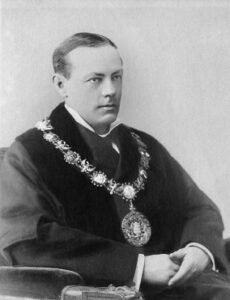
ARTHUR WHITEHEAD © Salisbury Guildhall
It remained under Mr. Whitehead’s personal guidance until about 1910, during which time practically every local event of importance – either artistic or social – took place within its walls. Mr. Whitehead was very aware that for many years, the Assembly Rooms which stood in the High Street (and now Waterstones Bookshop), had been one of the city’s most important centres of social life. Indeed, the Assembly Rooms dated back to 1804 and had attracted many eminent artists.

THE ASSEMBLY ROOMS ON THE CORNER OF THE CANAL & HIGH STREET © Salisbury Library
The Swedish Nightingale, Jenny Lind gave a recital at the Assembly Rooms in September 1856, and in September 1862 there was a visit from the world famous singer Madam Patti. Also, the great Pianist Franz Liszt played in the rooms on several occasions. But Arthur Whitehead was determined that his grand new theatre venue would be built in the Queen Anne style and accommodate up to 2,500 people in comfort. As mentioned, this came to pass in 1889.
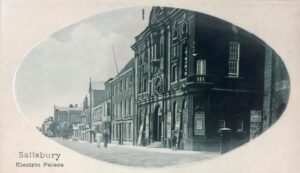
THE COUNTY HALL LATER RENAMED THE ELECTRIC PALACE THEATRE – ENDLESS STREET © Frogg Moody Collection
This little news item from the Salisbury Journal caught my eye regarding the Palace Theatre;
Win Paddock is a woman with memories. She remembers the old days well, and most of all, sitting on a step talking to ‘Lady Smasher’ – Charlie Chaplin.
At the age of 73 she recalls the days when she lived at St. Edmunds Church Street, near the old Palace Theatre, and the twopence-a-seat merry musical days, that now seem so far away.
“I was coming out of the Salvation Army when I met him” she said. “Charlie was lodging with a woman in the same street, I used to help out, and he used to chat to me and my girl friends.” She added, “He was a real lady smasher. Such a nice looking young man with dark eyes and curly hair. I suppose he must have been about 16 at the time. Charlie spent a fortnight in the city and I can remember sitting on the steps of the old steam laundry talking to him” she went on, “and then he went across the road and bought some liquorice bootlaces which we ate. He really was genuinely funny…..
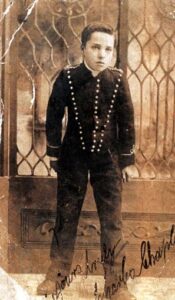
A YOUNG CHARLIE CHAPLIN WHO APPEARED AT THE PALACE THEATRE IN ENDLESS STREET © Universal Photographs
As the success of the Palace Theatre continued, it was taken over by a great pioneer of motion pictures, Mr. Albany Ward.

ALBANY WARD – A GREAT PIONEER OF EARLY CINEMA
© Universal Photographs
Albany Ward was born in 1879 in Stoke Newington, London. As a young man he recognised that the new world of film could be big business and in 1898, aged just 19, he started his own business as a projectionist, taking films to venues around the country. By 1914 he owned and ran the largest cinema circuit in the country and his head office was here in Salisbury.
At the outbreak of WW1 he knew with equal certainty that the tens of thousands of soldiers heading to Salisbury Plain would need entertaining. In later life he wrote: “I at once decided to offer my services to the War Department… I opened The Palace, Codford, within two days of war being declared.”
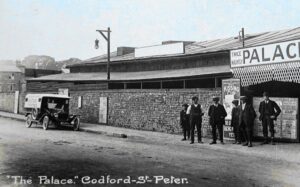
THE PALACE, CODFORD © Frogg Moody Collection
Albany Ward went on to open cinemas in every camp in the Southern Command area, including Larkhill, Fovant, Hurdcott, Sutton Veny, Heytesbury and two at Bulford.
The cinemas were well equipped and heated and he recalled: “I think I can justly say that my theatres were the most comfortable buildings in the respective camps and the troops were only too glad to go to them at night, knowing they would be warm and comfortable.”
This military cinema circuit was in addition to the 29 film theatres run by Albany Ward in the south west, including three in Salisbury – New Theatre in Castle Street, The Picture House in Fisherton Street and The Palace in Endless Street.
As the war progressed Albany Ward struggled to keep staff as they enlisted or, later, were conscripted. Ward feared he too could be called up and sought reassurance from the Army that his cinema circuit for the troops was important war work. Southern Command’s Lieutenant General Campbell agreed and wrote that Albany Ward was doing “great work for the nation” and would not be called to the colours.
At the end of the war the military authorities took over the running of camp entertainment. Albany Ward continued running his civilian circuit of theatres and picture houses until the early 1920s, eventually selling to the larger cinema companies who were taking control. He remained in Salisbury, focusing on his successful printing business, The Salisbury Press, Fisherton. Albany died in 1966, aged 86.
Albany Ward had first exhibited his ‘Imperial Electric Pictures’ at the Country Hall in 1908. In the winter of 1910 he leased the County Hall,
re-named it ‘The Palace’, and presented a combination of what he called ‘Perfect Pictures’ and ‘Variety’. In the same year he opened the ‘New Picturedrome and Theatre’ next to the Avon pub in Castle Street, with, as its first screen epic, ‘The Sorrow of Satan’.
In 1913 he spent £1500 transforming the ‘New Picturedrome and Theatre’ into simply ‘The New Theatre, and although films were still frequently shown there, the New Theatre gradually became the principal theatre of the city. Albany Ward was something of a do-gooder and made the opening show at the New Theatre in Castle Street a charity performance in aid of Shunter Applin, who had lost both feet in the course of his duty as a railway shunter in Fisherton. To my mind, Albany Ward is something of a legend and in 1954 he clamed to be the oldest living representative of the cinema industry in the country.
The First World War brought a great resurgence of life to the theatre in Salisbury with variety shows and three act plays being put on every week at the New Theatre, while the Palace combined variety shows and star films in its programme.
The First World War also brought a change in the life of the Primitive Methodist Chapel in Fisherton Street.

THE PRIMITIVE METHODIST CHAPEL IN FISHERTON STREET
© Frogg Moody Collection
As a result of the heavy floods to which Salisbury was subject in those days, the chapel building had suffered extensive damage from time to time and was difficult to keep in good repair. This is one of the reasons the trustee’s decided to sell, and to erect better premises in Dews Road. The last service at the chapel was held on Sunday October 15th, 1915. In view, however, of Albany Ward’s strong lead in pioneering cinema in Salisbury, it was rather naïve of the trustee’s to sell him their premises, as the Salisbury Times had reported in the issue of 15th June 1915, ‘On the understanding that he is going to convert them into a motor garage.’ He did in fact spend the fabulous sum of £7000 converting the chapel into ‘The Picture House’ under the direction of an architect called Michael Harding. The front of the chapel building was demolished and underpinned during the construction of a cinema front covering the original forecourt.


THE PICTURE HOUSE, FISHERTON STREET
© Frogg Moody Collection
The conversion caused a great deal of anger on the part of the church trustee’s, but having neglected to obtain written assurances from Mr. Ward, they were powerless to do anything.
Probably owing to wartime difficulties the work went forward slowly and it was Monday December 11th 1916 before the picture house opened with the showing of the ‘New Official War Film: The King with his armies on the Somme’ and ‘The Tanks, an amusing and unique cartoon’. This was to be followed later the same week with Marie Tempest in ‘Mrs. Plum’s Pudding’. The announcement of the Grand Opening included the promise that ‘Tea will be supplied free at all matinee performances’, and stated that the entire amount of the first day’s receipts would be given the Mayor’s fund for the Salisbury Infirmary. The films were silent and were accompanied by a piano to lend dramatic effect to such offerings as ‘The Perils of Pauline’ and ‘The Adventures of Pearl White’. The projection room was at the back of the stalls and the projectionist was assisted, in the school holidays, by a boy called Francis Pullen.

A VIEW INSIDE THE PICTURE HOUSE © Arthur Millie
The cinema began to have more and more of a hold on the world of entertainment and many of the original pioneers of moving films went out of business in the fierce competition with large organisations. Although the Palace in Endless Street and the New Theatre in Castle Street continued in their dual functions, putting on both live and film shows into the early 1930’s, the building of modern cinemas spelled the end for the more individual enterprises. In 1930 Harry Tate appeared at the Palace Theatre and in August of that year, names like Irene Worth and Lily Langtry were billed. But the days of the Palace were numbered and the following year Albany Ward sold up his interests and left for Bristol. The last show at the Palace ran for the week beginning 25th May 1931. It was entitled ‘Eve’s Daughters’ and was advertised as ‘a garden of beauty, grace and song and laughter’. In September 1931 the Gaumont British Wonder Theatre opened in the New Canal (today our Odeon Cinema) with ‘The Chance of a Night Time’ and ‘A Yank at King Arthur’s Court’.

THE GAUMONT PALACE OPENED IN 1931
© Frogg Moody & Richard Nash
The Gaumont Palace in the New Canal was re-named the Odeon in 1962.
The New Theatre in Castle Street struggled on a little longer than the Palace Theatre, having been fitted up with talkie apparatus during February of 1931 and re-opening later that year. It lasted only until the end of April 1932, by which time it had become known as a regular ‘flee-pit’ and closing it down no doubt came as a happy release, although it left Salisbury with no theatre as such. I remember reading somewhere that The New Theatre specialised in showing Westerns which were accompanied by a young woman, Miss Violet Southey, at the piano. Later on, artists performed their acts in the interval between the two major films. The long narrow building could seat about 600 people. There was no balcony as such, though the back seats were raised from gangway level. The theatre was closed and taken over by ‘Wiltons’ in 1935. Messrs. William Dibben and sons also had the site for many years. Although the building was gutted, the stage at the river end was used for storage space until demolition work started in 1957.
In 1935 there was talk of reviving the Palace Theatre as a modern cinema and also of building a cinema opposite the Palace which would seat 2000. The later proposal materialised in the form of the Regal Cinema, which is now a The Everyman Cinema. The first manager of the Regal was Mr. Hugh Melville Burge who stayed there for 31 years. Mr. Burge was born in Wales where, at the tender age of 10, he became the proprietor, manager, projectionist, bill-poster and attendant of Burge’s Cinema – a shed in his back garden! Whilst manager at the Regal he won many honours including an award in 1951 when the Regal was one of 25 A.B.C. theatres entered in the Bournemouth district competition for good time-keeping and general management. Salisbury and Mr. Burge was placed first.
Nothing came of the proposal to revive the old Palace Theatre, and in 1937, the building was converted into a garage – ‘The Palace Garage’ Endless Street.
Attempts had been made to save the Palace Theatre before its closure in 1931, but local people responded so poorly to the effort to form a company to keep it going that it was abandoned. I have taken a keen interest in researching The Palace Theatre so please forgive me if I just reflect on some of the features. It was designed by architect Mr. Fred Bath. Here are some particulars of the establishment. The stage was 46 feet wide, with a depth of 30 feet, the front being 4 feet above the floor, rising to 5 ft. at the back. The flooring was solid 3in. batten and was fixed on iron girders without joists, with a view to giving a good fixing for stage properties and scenery, and also of resisting the spread of fire in case of outbreak! All the stage curtains were of gold plush velvet with terra-cotta trimmings. The hall was 70 ft. long by 30 ft. wide and comfortably seated 650 persons and there was a balcony which accommodated another 350. The external portions of the building was designed and freely treated in the Queen Anne style – the woodwork was of pitch-pine the windows being painted white, and the doors peacock blue. The whole of the works (except the stage fit-up), was carried out by Messrs. Webb and Co of Salisbury.
This is the only known image yet found inside the Palace Theatre.

THE PALACE THEATRE, ENDLESS STREET, SALISBURY.
© Frogg Moody Collection
The local papers lamented the closure of both the New Theatre in Castle Street and the Palace Theatre in Endless Street thus; Both theatres will linger on in the minds of the hundreds of thousands of troops in training around Salisbury during the Great War. In spite of the shadow of war, and the darkened streets outside, both places were then at their gayest. Cheery, happy audiences were theirs, cheery for a few brief hours as a respite from the weeks of concentrated training before they were sent overseas.
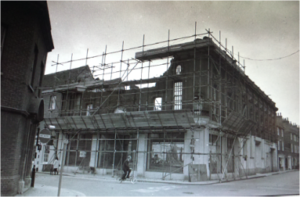
THE DEMOLISHION OF THE PALACE THEATRE, ENDLESS STREET IN 1968 © Salisbury Newspapers
What a tragedy for Salisbury that this magnificent building was ever allowed to be demolished. The Salisbury Times reported this little gem – ‘The demolition of the old Palace Theatre in Endless Street, a relic of the early days of entertainment, will have brought a touch of sadness to some, but none more than 78 year old Tom Bromham of 50 Hulse Road, who trod the boards there as Tom Clifford, the famous ventriloquist in 1908. It was well over half a century ago when Tom appeared before Salisbury audiences as a star in his own right having shared the bill with Marie Lloyd, George Robey, Harry Lauder and an up and coming star called Charlie Chaplin.’
In 1968 Tom’s local was the Rising Sun in Castle Street where he would often sing the old music hall songs from the past
Let us now return to Picture House in Fisherton Street. Talkie apparatus was installed in November 1935 and Mr. Jack Overton gave this account to the Salisbury Journal. “I was born in Exeter Terrace, Salisbury, in 1904 and started work as an assistant projectionist for the Palace Theatre in November 1918. I was there for only 8 months when I moved to the New Picture House in Fisherton Street (Just to reiterate, this was originally the primitive Methodist Chapel.) I stayed there for 8 years as chief projectionist and during this time, I became the first projectionist in Salisbury to introduce ‘Talkie’ films.” In fact, Jack recalled that this first film starred Chester Morris in ‘The Perfect Alibi.’ Jack Overton spent many years as a projectionist in other towns and cities finally returning to Salisbury and the Gaumont Palace, the Canal in 1941 where he spent nearly 30 years as chief projectionist. Retiring in 1968, Mr. Overton had been a projectionist for 50 years.
Arthur Millie who is volunteer archivist at Salisbury Playhouse gave me this information.
“The Picture House in Fisherton Street flourished until 1937 when a decline set in as other cinemas opened up in the city. The building was put up for sale and in 1939 the local military authorities requisitioned it as a Drill Hall and an Army Recruitment Centre. Eventually in 1943, ENSA (Entertainment and National Service Association) took it over and the Royal Engineers transformed it into the Garrison Theatre Southern Command to serve the soldiers of the local garrisons.”
When the War ended, ENSA relinquished the lease on the building and the Arts Council took over the running of the theatre. It was named the Arts Theatre and was officially opened in 1945.”
The Playhouse building was becoming rather a sick patient and in 1974 an appeal was launched to build a new Playhouse on the Maltings where it remains to this day. It was a struggle but the 3/4 million was raised and the new building was opened on 30th November 1976 by Sir Alec Guinness. The last play at the old theatre was an “Olde Tyme Music Hall”.

THE OLD PLAYHOUSE, FISHERTON STREET
© Frogg Moody Collecetion
On February 7th 1936, the local press announced news of yet another new cinema to be built virtually right next door to the Picture House in Fisherton Street. Under the heading, New Gaumont-British Cinema for Salisbury. Fisherton St. project well in hand it stated – ‘A new cinema, with a seating capacity of 1600 will shortly be erected in Fisherton St, Salisbury, by the Gaumont-British Picture Corporation.
It has been known for some time that this Corporation, who controls the Gaumont Palace in the Canal and the Picture House in Fisherton Street. had contemplated an extension of their service in Salisbury, and we are informed by a leading official of the company that negotiations for an entirely new site in a commanding position in Fisherton St. are on the eve of completion.
Within a few days plans of the cinema will be lodged with the City Council, and building operations will start in the very near future. The main entrance of the cinema will be in Fisherton St, and the building will include all the up-to-date amenities for which the Gaumont-British Corporation are noted.’
In fact, two new cinemas opened in Salisbury in 1937. Alan Richardson has documented the history of cinema in Salisbury better than any man and is someone who we owe a great dept – as we will hear later. But I will let the words of Alan describe the happenings of 1937.
“The late thirties were the great boom years of the cinema, and Salisbury was no exception to the prevailing trend for this type of entertainment. In 1937 two sparkling new cinemas opened to the public. The Regal cinema belonging to the Associated British Picture Corporation (ABC) entered the movie race and opened its doors in Endless Street, almost alongside the old Palace Theatre.
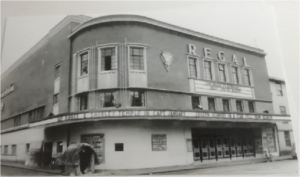
THE REGAL CINEMA, OPENED IN 1937
© Frogg Moody & Richard Nash
It was a warm red brick building with pleasing curves, very much in the trend of cinema design for the mid-thirties. The 1600 patrons on the first night, February 22nd, 1937 enjoyed seeing the latest Shirley Temple film ‘Captain January’ supported by a second feature entitled, ‘A Star fell from Heaven’, with Joseph Schmidt in the title role.

THE REGAL ADVERT © Frogg Moody & Richard Nash
Seven months later on September 27th the ‘New Picture House’ in Fisherton Street offered its delights to the eager public with the film ‘King Solomon’s Mines – which engulfed a further 1311 citizens.
It was very smart indeed with a long spacious entrance leading to a roomy foyer, before entering the striking auditorium which was of the stadium type, that is with the seats behind the stall entrances rising in a steep rake, rather than having the conventional balcony isolated from the stalls area. The stage was a rather delicate affair with charming slender silver columns framing the stage with its curtains of cream and peach with green and gold trimmings. It was a very popular cinema with the younger set, processing a rather special and intimate atmosphere of its own.”

THE NEW PICTURE HOUSE, FISHERTON STREET
© Frogg Moody & Richard Nash
These two cinemas did very well because this was the 1930’s – the golden era of films and even when the second world war came along, the cinemas were nearly always full – an escape for a few hour from the bleakness of war just like Albany Ward had provided during the first campaign. Eventually, the ‘New Picture House was bought by the city council and became, in 1962, what is today’s City Hall. However, this was the first cinema in Salisbury to publicly exhibit an X film – ‘A Streetcar Named Desire’ Monday March 10th 1951.
Going back to the Regal or ABC as many here will remember it. I well remember my dad packing me off to get some peace and quiet for a few hours on a Saturday morning!
On January 25th 1969, the ABC announced that films would cease to be shown. Bingo was going to be the star attraction and 200 seats were ripped out from the stalls to make way for the bingo tables. In 2023 we came a full circle when the Bingo Hall closed and the Everyman Cinema opened up for business.

THE EVERMAN CINEMA © Salisbury Newspapers.
Another project that was mooted in 1936 didn’t quite happen! Convinced by the keen desire of the Salisbury public for entertainment other than pictures, a company was formed with the intention of erecting a modern and well appointed theatre called ‘The Phoenix Theatre’ in Fisherton Street to provide first class variety entertainment, musical comedies and drama. Plans of the building were passed by the City Council which allowed accommodation to seat 1000 persons. The company ‘The Phoenix Theatre Salisbury Ltd’ promised that every facility would be given to local amateur societies to present their productions.
The company stated that there was to be an issue by public subscription of 40,000 shares of £1.00 each. The Chairman of directors was Mr. W. Fielden of Salisbury, managing director of the Salisbury Gas Company and a director of the Wilts and Dorset Motor Services Ltd. Another director was Mr. A.E.S. Story of Southampton – he was also managing director of the Southampton Hippodrome.
The company had an option on property in Fisherton Street and also in Crane Bridge Road. If the necessary capital could be subscribed, the property owned by The Magnet Stores would be purchased for £9500 and number 8, Crane Bridge Road, would be purchased for £2300. But the Salisbury inhabitants treated the scheme with indifference and virtually nobody bought the £1.00 shares so the scheme fell through.
So what would the Phoenix Theatre have looked like in Fisherton Street? Here’s the official drawing as passed by the City Council.

THE PHOENIX THEATRE © Salisbury Newspapers
Now as we’ve already seen, The Palace Theatre in Endless Street, The New Theatre in Castle Street and The Picture House in Fisherton Street have all been demolished – wonderful buildings now gone forever.
In 1986, it was the turn of the Odeon in the Canal to be chosen by the property developers for demolition to make way for a shopping arcade. But cometh the hour, cometh the man and that man was Alan Richardson. Alan was the authority on the history of the Odeon indeed, it was his own mother’s needlework shop that became the Catherine Street entrance to the front stalls of what was then the Gaumont Palace. Alan conducted a one-man campaign to save his beloved cinema and he organised a local action group dedicated to preventing the demolition. Letters of support appeared in the Journal and indicated to Alan that he was not alone – but there can be no doubt that not only was he the leading light of the campaign, but the brains behind it as well. Eventually, helped by a strong local community protest, the demolition proposal was averted and Alan’s ‘Save the Odeon’ campaign is the only reason that the cinema still stands today.

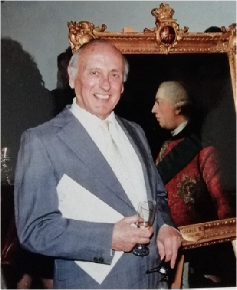
THE ‘SAVE THE ODEON’ CAMPAIGN MASTERMINDED BY
ALAN RICHARDSON ©Frogg Moody & Richard Nash